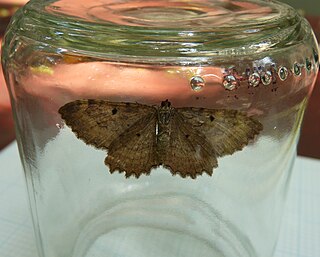
Coryphista is a monotypic moth genus in the family Geometridae erected by George Duryea Hulst in 1896. The genus may be considered to be a synonym of Rheumaptera. Its only species, Coryphista meadii, the barberry geometer moth or barberry looper, was first described by Alpheus Spring Packard in 1874. It is found in the United States and southern Canada.

Tetracis is a genus of moths in the family Geometridae erected by Achille Guenée in 1858.
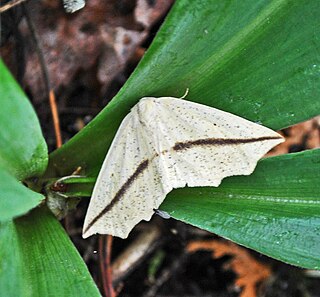
Tetracis crocallata is a moth of the family Geometridae first described by Achille Guenée in 1858. It is found in North America from Nova Scotia, New Brunswick, southern Manitoba and southern Saskatchewan to Alberta, south to northern Florida, west to Kansas, Nebraska, North Dakota and extreme eastern Texas.
Tetracis australis is a moth of the family Geometridae. It is found from the coastal southern regions of the U.S. state of California from Monterey County south to Los Encinas, San Pedro Martir, Baja California, Mexico, at altitudes from near sea level to 2,135 meters.

Tetracis cachexiata, the white slant-line or white slaut, is a moth of the family Geometridae. The species was first described by Achille Guenée in 1858. It is found in North America from Nova Scotia to central British Columbia, south to northern Florida and west to Montana and northern Colorado.

Tetracis cervinaria is a moth of the family Geometridae first described by Alpheus Spring Packard in 1871. It is found in North America from British Columbia south to Kern County, California and eastward to western Montana, south-eastern Idaho, Carbon County, Wyoming and Larimer County, Colorado. It is found at elevations of 790 to 2,375 meters.
Tetracis fuscata is a moth of the family Geometridae first described by George Duryea Hulst in 1898. It is only known from the US states of Colorado and Wyoming.
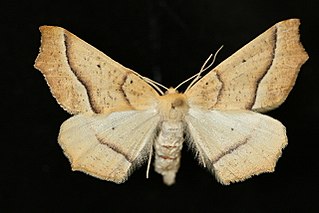
Tetracis pallulata is a moth of the family Geometridae first described by George Duryea Hulst in 1887. It is found in western North America from southern California north to British Columbia, east to Idaho and western Montana from near sea level to 2,200 meters.
Tetracis mosesiani is a moth of the family Geometridae. It is found coastal California from near sea level to 915 meters.
Tetracis jubararia is a moth of the family Geometridae. It is found in North America.
Tetracis montanaria is a moth of the family Geometridae. It is only known from south-eastern Arizona. It is found in aspen-coniferous forests on altitudes between 2,440 and 2,715 meters.
Tetracis barnesii is a moth of the family Geometridae. It is found from the high-desert riparian canyons in Colorado and Utah to the dry coniferous forest in Oregon on altitudes between 1,555 and 1,905 meters.
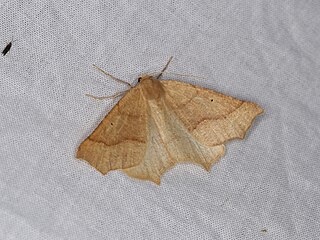
Tetracis hirsutaria is a moth of the family Geometridae first described by William Barnes and James Halliday McDunnough in 1913. It is found in the United States in California and extreme southern Nevada.
Tetracis pallidata is a moth of the family Geometridae first described by Clifford D. Ferris in 2009. It is found in British Columbia, Idaho and Washington.
Eupithecia insolabilis is a moth in the family Geometridae first described by George Duryea Hulst in 1900. It is found in the southern United States, including Utah, Arizona and New Mexico.
Eupithecia sierrae is a moth in the family Geometridae first described by George Duryea Hulst in 1896. It is found in North America, including Colorado, Wyoming, southern Utah, New Mexico, Arizona and California.

Eupithecia nimbicolor is a moth in the family Geometridae first described by George Duryea Hulst in 1896. It is found in North America from eastern Newfoundland and Labrador to western British Columbia and from Alaska to Arizona.
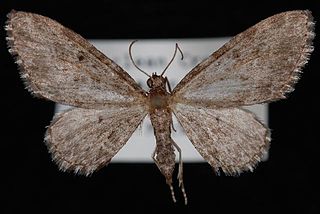
Eupithecia lachrymosa is a moth in the family Geometridae first described by George Duryea Hulst in 1900. It is found in North America from central Saskatchewan west to southern Vancouver Island, north to British Columbia and Alberta and south to California.
Eupithecia flavigutta is a moth in the family Geometridae first described by George Duryea Hulst in 1896. It is found in the United States in Colorado and montane forest areas in eastern Arizona and south-western New Mexico.

Eupithecia misturata is a moth in the family Geometridae first described by George Duryea Hulst in 1896. It is widely distributed in western North America.
This page is based on this
Wikipedia article Text is available under the
CC BY-SA 4.0 license; additional terms may apply.
Images, videos and audio are available under their respective licenses.









